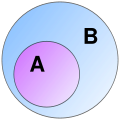Self-verification is a social psychological theory that asserts people want to be known and understood by others according to their firmly held beliefs...
24 KB (3,407 words) - 04:16, 6 June 2025
Self-verifying theories are consistent first-order systems of arithmetic, much weaker than Peano arithmetic, that are capable of proving their own consistency...
3 KB (419 words) - 20:57, 24 May 2025
Self-awareness Self-categorization theory Self-concept Self-enhancement Self-esteem Self-perception theory Self psychology Self-verification theory Social...
41 KB (5,632 words) - 03:19, 8 July 2025
Impression management (redirect from Self-presentation theory)
(sociolinguistics) Reputation capital Reputation management Self-monitoring theory Self-verification theory Signalling (economics) Spin (public relations) Superficial...
74 KB (9,670 words) - 22:12, 22 May 2025
Verificationism, also known as the verification principle or the verifiability criterion of meaning, is a doctrine in philosophy which asserts that a...
19 KB (2,036 words) - 13:31, 2 July 2025
William Swann (section Self-verification theory)
and undergraduate degree from Gettysburg College. Swann devised self-verification theory, which focuses on people's desire to be known and understood by...
14 KB (1,403 words) - 20:46, 17 June 2025
Self-perception theory (SPT) is an account of attitude formation developed by psychologist Daryl Bem. It asserts that people develop their attitudes (when...
23 KB (3,186 words) - 19:08, 5 October 2024
verification, and software testing. Since Boolean satisfiability is already NP-complete, the SMT problem is typically NP-hard, and for many theories it...
46 KB (4,371 words) - 23:30, 22 May 2025
our likes and dislikes. Extrinsic self perceptions can lead to the over-justification effect. Self-verification theory – focuses on people’s desire to be...
6 KB (795 words) - 09:47, 3 February 2024
major role in the theory of computation, compiler construction, artificial intelligence, parsing and formal verification. The theory of abstract automata...
32 KB (3,851 words) - 10:11, 30 June 2025
The self-discrepancy theory states that individuals compare their "actual" self to internalized standards or the "ideal/ought self". Inconsistencies between...
26 KB (3,584 words) - 14:30, 6 July 2025
(1651), Hobbes (using the English term self-defense for the first time) proposed the foundation political theory that distinguishes between a state of...
22 KB (2,914 words) - 04:58, 26 May 2025
William James (redirect from James's theory of the self)
is doing much to injure psychology". James' theory of the self divided a person's mental picture of self into two categories: the "Me" and the "I". The...
96 KB (12,709 words) - 09:20, 7 July 2025
the motives that drive self-evaluation, along with self-verification and self-enhancement. Sedikides (1993) suggests that the self-assessment motive will...
12 KB (1,739 words) - 14:11, 23 May 2025
Body dysmorphic disorder (section Self-improvement)
order to fulfill their self-esteem needs. The self-verification theory, explains how individuals use selfies to gain verification from others through likes...
40 KB (4,524 words) - 21:15, 11 July 2025
In set theory, Zermelo–Fraenkel set theory, named after mathematicians Ernst Zermelo and Abraham Fraenkel, is an axiomatic system that was proposed in...
46 KB (6,282 words) - 01:47, 21 July 2025
The self-care deficit nursing theory is a grand nursing theory that was developed between 1959 and 2001 by Dorothea Orem. The theory is also referred to...
4 KB (439 words) - 13:49, 15 April 2024
capacity of the private sector.[verification needed] MMT is opposed to the mainstream understanding of macroeconomic theory and has been criticized heavily...
69 KB (7,387 words) - 01:10, 22 July 2025
logic; Transfinite iteration of theories, due to Alan Turing and Solomon Feferman; The discovery of self-verifying theories, systems strong enough to talk...
20 KB (2,669 words) - 19:20, 5 July 2025
Multiple discovery (category All articles with self-published sources)
multiple discovery opposes a traditional view—the "heroic theory" of invention and discovery.[not verified in body] Multiple discovery is analogous to convergent...
20 KB (2,243 words) - 18:01, 29 March 2025
independent interest, they have eventually turned out to be central to the theories in which they occur. Look up lemma in Wiktionary, the free dictionary....
4 KB (399 words) - 21:11, 18 June 2025
§ 2. Three-Valued Conditionals Gottwald 2022, Lead section, § 2. Proof Theory Nederpelt & Geuvers 2014, pp. 159–162 Sørensen & Urzyczyn 2006, pp. 161–162...
66 KB (7,327 words) - 08:42, 9 June 2025
true self (also known as real self, authentic self, original self and vulnerable self) and the false self (also known as fake self, idealized self, superficial...
17 KB (2,264 words) - 09:31, 11 May 2025
In automata theory, a self-verifying finite automaton (SVFA) is a special kind of a nondeterministic finite automaton (NFA) with a symmetric kind of nondeterminism...
4 KB (468 words) - 06:31, 14 April 2025
The self-worth theory of motivation, which is adapted from the original theory of achievement motivation, describes an individual's tendency to protect...
20 KB (2,473 words) - 18:06, 9 June 2025
Self (psychology) Self-assessment Self-awareness Self-categorization theory Self-consciousness Self-control Self-efficacy Self-esteem Self-image Self-knowledge...
63 KB (7,679 words) - 16:55, 18 July 2025
cognitive theory. Self-efficacy represents the personal perception of external social factors. According to Bandura's theory, people with high self-efficacy—that...
82 KB (9,808 words) - 04:04, 19 July 2025
Caloric theory – the theory that a self-repelling fluid called "caloric" was the substance of heat. Rendered obsolete by the mechanical theory of heat...
26 KB (3,004 words) - 10:27, 12 July 2025
Cognitive-experiential self-theory (CEST) is a dual-process model of perception developed by Seymour Epstein. CEST is based around the idea that people...
17 KB (2,185 words) - 01:03, 3 February 2024
Subset (redirect from Inclusion (set theory))
{\displaystyle k} -subsets of an n {\displaystyle n} -element set. In set theory, the notation [ A ] k {\displaystyle [A]^{k}} is also common, especially...
11 KB (1,734 words) - 18:05, 12 March 2025







